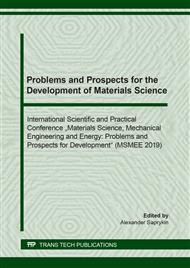[1]
A.S. Razumov, I.L. Pasholok, V.N. Zyurenko, Wheels of increased operational durability for freight cars of a new generation / Sat. scientific Tr .: The development of railway transport in the context of reform. M .: Intext, 2003. pp.199-206.
Google Scholar
[2]
E.S. Yagodinsky The nature of damage to parts of the coupler and methods for their restoration // Collection of scientific works UkrDAZT - 2014. 145 - pp.171-174.
Google Scholar
[3]
G.I. Brunchukov Methods to improve the operational durability of locomotive tires / Sb. scientific Tr.: The development of railway transport in the conditions of reform. M .: Intext, 2006. pp.214-220.
Google Scholar
[4]
M.F. Verigo The reasons for the increase in the intensity of lateral wear of rails and wheel flanges. M .: Transport, 1992.46 p.
Google Scholar
[5]
P. Clayton, K.J. Sawley, P.J. Bolton, G.M. Pell, Wear of bainitic steels // Wear. N120. 1987. p.pp.199-220.
DOI: 10.1016/0043-1648(87)90067-6
Google Scholar
[6]
M. Ueda, K. Uchino, H. Kageyama, K. Motohiro, A. Kobayash, Development of bainitic steel rail with excellent surface damage resistance STS-Conference: Wheel/Rail Interface. Moscow, (1999).
Google Scholar
[7]
S. Mitao, H. Yokoyama, S. Yamamoto, Y. Kataoka, T. Sugiyama, High strength bainitic steel rails for heavy haul railways with superior damage resistance. STS-Conference: Wheel/Rail Interface. Moscow, (1999).
Google Scholar
[8]
P. Clayton, R. Devanathan, Rolling/sliding wear behavior of a chromium-molybdenum rail steel in perlitic and bainitic conditions // Wear. N156. 1992. p.pp.121-131.
DOI: 10.1016/0043-1648(92)90148-2
Google Scholar
[9]
P. Clayton, X. Su, Surface initiated fatigue of perlitic and bainitic steels under water lubricated rolling/sliding contact // Wear. V. 200. 1996. p.pp.63-73.
DOI: 10.1016/s0043-1648(96)07250-x
Google Scholar
[10]
E.I. Meletis, X. Nie, F.L. Wang, J.C. Jiang. Electrolytic plasma processing for cleaning and metal-coating of teel surface. Surfce and Coatings Nechnology 150(2002), 246-256.
DOI: 10.1016/s0257-8972(01)01521-3
Google Scholar
[11]
V.K. Grigorevich, Hardness and microhardness of metals. - M .: Science, 1976. –230 p.
Google Scholar
[12]
S.А. Saltykov, Stereometric metallography. - M .: Metallography, 1970. – 376p.
Google Scholar
[13]
К.S. Chernyavsky, Stereology in Metallurgy. - Moscow: Metallurgy, 1977.- 280p.
Google Scholar
[14]
М.К. Skakov, B.К. Rahadilov, D.B. Zarva, A.V. Gulkin, Installation of electrolytic-plasma processing // Innovative patent for the invention of the Republic of Kazakhstan: IPC С255F 7/00 - № 29978 / Application. 03/02/2014; Publ. 15.06.2015, Bul. № 6.
Google Scholar
[15]
B. Rakhadilov, L. Zhurerova, A. Pavlov, Method of Electrolyte-Plasma Surface Hardening of 65G and 20GL Low-Alloy Steels Samples // IOP Conf. Series: Materials Science and Engineering.– 2016.–V. 142. pp.1-7.
DOI: 10.1088/1757-899x/142/1/012028
Google Scholar
[16]
M. Skakov, B. Rakhadilov, E. Batyrbekov, M. Scheffler, A. Manapbaeva, G. Ayapbergenova, G. Karipbayeva: Influence of regimes electrolytic-plasma nitriding on the structural-phase state and the wear of steel P6M5. Bulletin of KazNTU (2014), No. 3 (103), pp.65-71.
DOI: 10.4028/www.scientific.net/amr.904.217
Google Scholar
[17]
M. Skakov, B. Rahadilov, G. Karipbayeva, A. Manapbaeva: Structure-phase state of high-speed steel P6M5 after heat treatment. Bulletin of KazNU (2014), No.1 (48), pp.53-59.
Google Scholar
[18]
N. A. Popova, L. G. Zhurerova, E. L. Nikonenko, M. K. Skakov: Effect of Plasma Electrolytic Nitrocarburizing on Phase Composition of 0.3C-1Mn-1Si-Fe Steel. ISSN 2075-1133, Inorganic Materials: Applied Research, (2017), Vol. 8, No. 1, p.130 –135.
DOI: 10.1134/s2075113317010300
Google Scholar
[19]
B.K. Rahadilov, M.K. Skakov, T.R. Tulenbergenov, Tungsten Surface Erosion by Hydrogen Plasma Irradiation // Key engineering materials. – 2017. – Vol.736. – P. 46-51.
DOI: 10.4028/www.scientific.net/kem.736.46
Google Scholar


